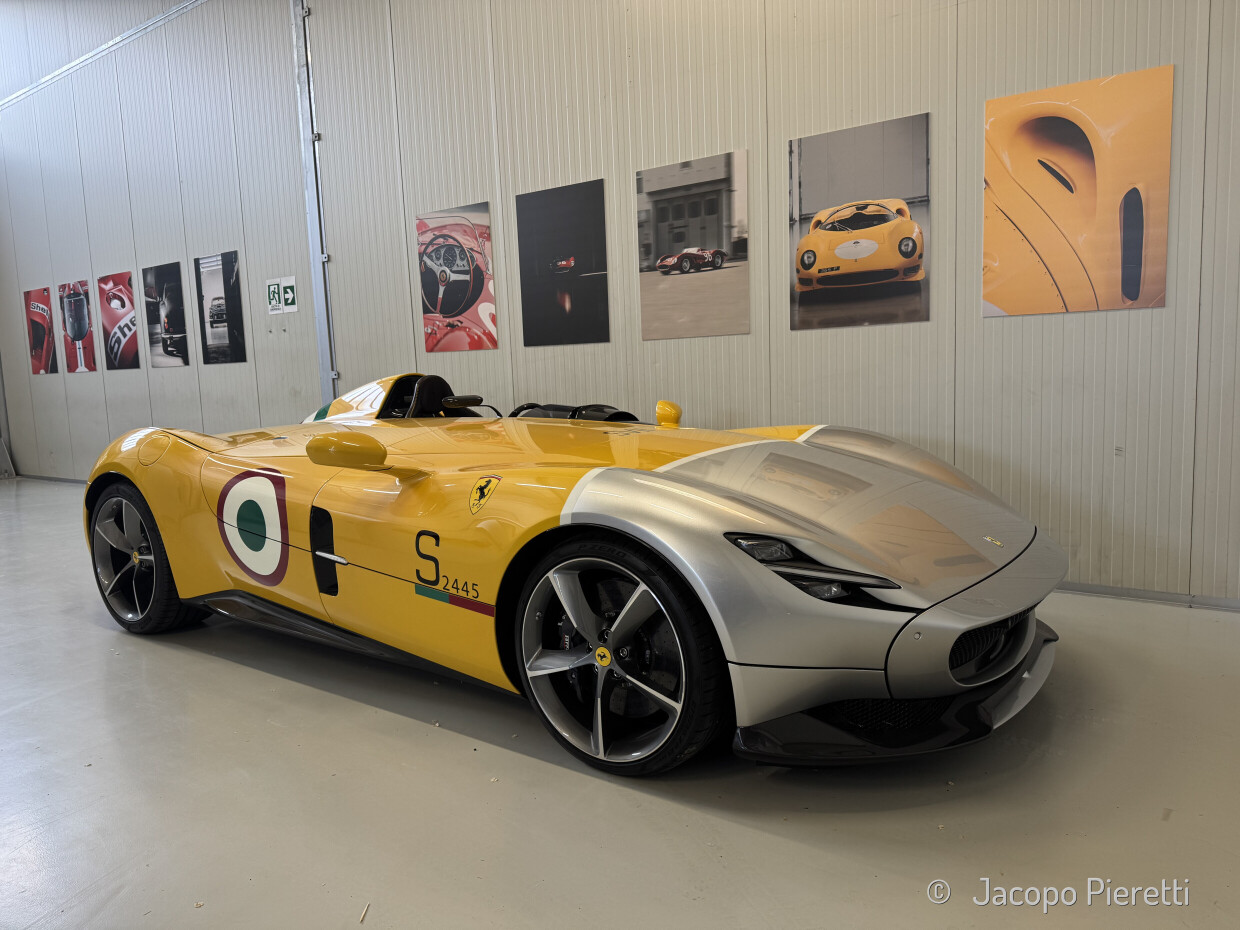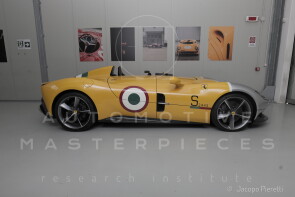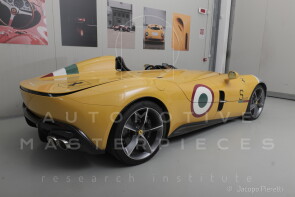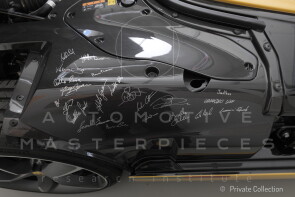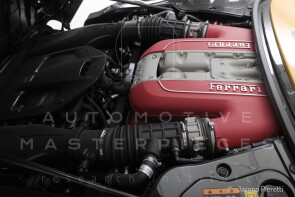
2020 Ferrari Monza SP1
ON/OFF
Why am I an Automotive Masterpiece?
L. Limited edition cars
no. 100 manufactured
Ferrari's passion for innovation opened a new chapter with the Monza SP1 and SP2, unveiled in early autumn 2018 for the 2019 model year. These are the first models in the "Icona" series, a special project aimed at creating limited-series cars inspired by Ferrari classics, reserved for selected clients. The Monza SP1 and SP2 draw stylistic inspiration from historic models such as the 166 MM, 750 Monza, and 250 Testa Rossa, all icons of the post-war Sport barchetta category. That era marked the reign of the barchettas—racing cars in the Sport class combining extreme mechanics with minimalist, functional styling shaped by aerodynamic efficiency. Their design was pure and purposeful, engineered to cut through the air. Yet, the master coachbuilders of the time added character to this simplicity, creating unique lines that became timeless works of art. These cars lacked modern comforts: no roof, no windows, no audio systems, no trunk—just a spare wheel behind the seats. But none of that mattered. Their elegance and charisma were irresistible. It's said that even a young Gianni Agnelli was so captivated that he commissioned Touring to clothe a 166 MM chassis and engine (chassis 0064M). Ferrari barchettas starred in legendary races and earned historic victories—events now immortalized in books and celebrated at top-tier auctions: Mille Miglia, Le Mans, Sebring, Targa Florio. In modern times, only a few creations have echoed that spirit: the Pininfarina-built Mythos prototype, the topless F50, and the unique 360 Barchetta (118775) built for Luca Cordero di Montezemolo. The Monza SP1 and SP2 are the first production models to pay homage to that era: fully road-legal spiders—one single-seater, one two-seater—strictly open-top, with minimalist interiors and a small deflector in place of a windshield. The SP1 embodies the essence of this concept: a single-seat layout that allows the driver to experience the thrill of uncompromised driving. A total of 499 units were built between the SP1 and SP2 (about 100 the former, 400 the latter), with prices starting at €1.58 million, excluding extras. The Ferrari Monza SP1 measures 4,657 mm in length, 1,996 mm in width, 1,115 mm in height, and has a wheelbase of 2,720 mm. Its chassis derives from the 812 Superfast and was modified for the barchetta configuration, built around a carbon fiber monocoque. The body is entirely made of composite material, including the large clamshell hood. Suspension features double wishbones at the front and a multilink setup at the rear, with magnetorheological electronically controlled dampers on both axles. Like the F12tdf, it features rear-wheel steering: at low speeds, the rear wheels turn opposite to the front; at high speeds, they turn in the same direction. This creates a virtual short wheelbase effect that enhances lateral grip. The braking system features carbon-ceramic discs by Brembo—398 mm front, 360 mm rear—paired with aluminum monobloc calipers. The car rides on 21-inch Speedline alloy wheels with 275/35 ZR 21 tires at the front and 315/30 ZR 21 tires at the rear. The declared dry weight is approximately 1,500 kg (SP2: 1,520 kg). Performance figures include 0–100 km/h in 2.9 seconds, 0–200 km/h in 7.9 seconds, and a top speed exceeding 299 km/h. The engine is a 65° naturally aspirated V12 derived from the 812 Superfast, with a bore and stroke of 94 x 78 mm, displacing 6,496 cc. It produces 810 hp at 8,500 rpm and 719 Nm at 7,000 rpm and was the most powerful Ferrari road-going V12 at the time. The intake uses variable-geometry ducts and direct high-pressure fuel injection. Valve timing is managed by dual overhead camshafts with four valves per cylinder. The 7-speed dual-clutch gearbox (type 530) is semi-automatic and paddle-operated. The manettino on the steering wheel adjusts driving modes, engine and gearbox behavior, and electronic differential response. A dedicated control changes the damping setup in real time. The SP1's design, developed by the Ferrari Styling Centre, is modern but avoids retro clichés. It’s shaped as two interlocking shells: a lower hull and upper cover. No roof, pillars, or windshield—a pure barchetta. The long hood and flowing fenders are met by a wide front intake and sculpted flanks. Brake ducts and side outlets manage airflow. The rear haunches form a fluid tail that transitions into a carbon diffuser and twin exhausts. To protect the driver, Ferrari developed the Virtual Wind Shield, channeling air over the hood into a duct that projects it over the cockpit, forming a low-turbulence flow. Inside, everything is focused on the driver: a leather-trimmed carbon seat, central instruments, and a body-colored tonneau that closes off the passenger side. In 2020, the SP1 received the Compasso d’Oro ADI, Italy’s top industrial design award. All Monzas were painted by Carrozzeria Zanasi in Maranello.
The 2020 Ferrari Monza SP1, chassis no. ZFF94MSB000262776, “Tribute to the 100th Anniversary of Francesco Baracca,” is a one-off example from the special “Icona” series, created by the Ferrari Tailor Made department to evoke the very origins of Ferrari history and as a tribute to the connection between Ferrari and the Italian Air Force. This car pays homage to Francesco Baracca (1888–1918), the foremost Italian air ace of the First World War, with 34 confirmed aerial victories. A former cavalry officer who transferred to aviation, Baracca became a symbol of courage and honor. Celebrated by Gabriele D’Annunzio as a modern knight of the air, he died in combat over Montello in 1918 and became a national hero. Baracca’s personal emblem—a black prancing horse on a white field—was painted on his aircraft in tribute to his former cavalry regiment. It symbolized continuity between cavalry and aviation, combining elegance and fighting spirit. The horse was usually shown rearing, tail down, occasionally facing left. Another theory suggests Baracca may have adopted the emblem from the coat of arms of Stuttgart, possibly from a downed German aircraft—thus linking the Ferrari and Porsche emblems by symbolic origin. The best-known version, however, comes from Enzo Ferrari himself. After winning the 1923 Circuito del Savio race, he met Countess Paolina Baracca, who urged him to use her son’s horse for good luck. Ferrari first used it in 1932, adapting it with a raised tail, a yellow background for Modena, and the letters “S F” for Scuderia Ferrari. The Baracca tribute SP1 is equipped with Ferrari’s standard naturally aspirated 6.5-liter V12 (type F140GC, serial no. 490915) and 7-speed dual-clutch transmission (type 530, no. 108074). The ISO LM01 livery features “Ardila Amarillo Lucido” yellow with “Sanu Silver” front finish, two fuselage-style roundels, and a tricolore stripe. The markings “SVII” and “S2445” refer to Baracca’s SPAD S.VII airplane. A shield at the rear bears the inscription “9° Stormo F. Baracca.” These elements reinforce the tribute to the celebrated aviator. The interior is trimmed in Heritage Testa di Moro leather with the prancing horse logo embossed on the headrest and yellow comb-stitching. The car features several personalized expensive extras. This SP1 “tribute” was revealed during exclusive events for Ferrari’s top-tier clients; it has been the subject of works by Ferrari artist and designer Enzo Naso and featured in various Ferrari-branded exhibitions, including Cavallino Modena. The car was sold by official dealer Rossocorsa to a private collection. In April 2021, it received the Certificate for Special Series Vehicles from Ferrari S.p.A. and was registered in 2022. To this day, the mileage remains that recorded upon delivery by Ferrari: 63 km.
